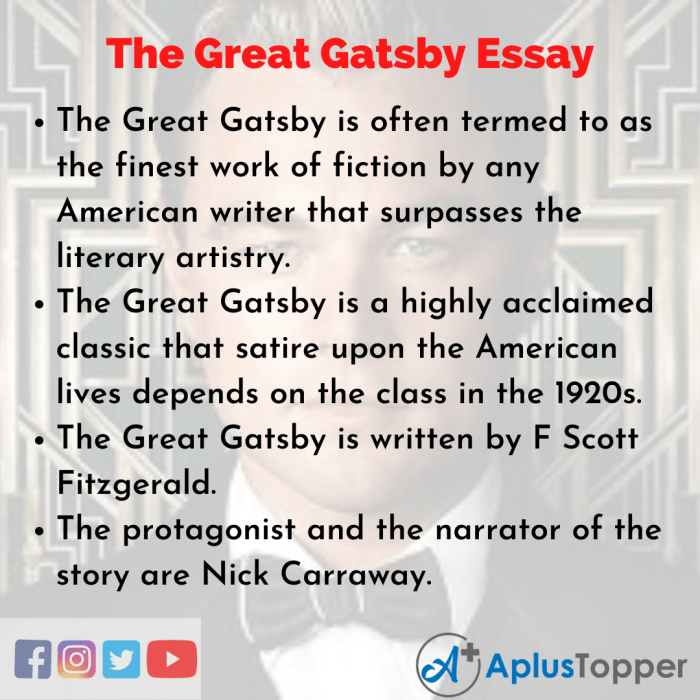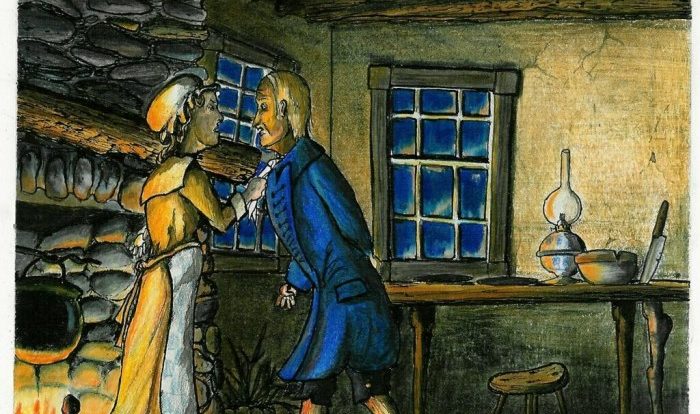Unveiling the profound depths of F. Scott Fitzgerald’s masterpiece, “Essay Ideas for The Great Gatsby” delves into the literary brilliance and enduring cultural impact of this iconic American novel. Through an exploration of its intricate themes, compelling characters, and evocative narrative style, this guide unlocks a wealth of insightful essay topics for students and scholars alike.
Delving into the novel’s literary devices, character analysis, and exploration of historical and social context, this guide provides a comprehensive framework for crafting well-structured and thought-provoking essays.
Literary Devices in The Great Gatsby
F. Scott Fitzgerald’s The Great Gatsby is a masterclass in literary craftsmanship, employing a rich array of literary devices to create a vivid and unforgettable narrative. From the evocative use of symbolism to the subtle interplay of foreshadowing and irony, these devices work in concert to enhance the novel’s themes, characters, and plot.
Symbolism
Symbolism is a cornerstone of The Great Gatsby, with numerous objects and images imbued with profound meaning. The most prominent symbol is the titular Gatsby’s green light, which represents his unattainable dream of reuniting with Daisy Buchanan. Other notable symbols include the Valley of Ashes, a desolate wasteland that embodies the moral decay of society, and the eyes of Dr.
T. J. Eckleburg, which serve as a constant reminder of God’s judgment.
Color Imagery
Color imagery plays a crucial role in establishing the novel’s atmosphere and characterization. The vibrant colors of Gatsby’s mansion and Daisy’s garden contrast starkly with the muted tones of the Valley of Ashes, reflecting the disparity between the wealthy and the poor.
The green light, a symbol of hope and longing, is a recurring motif throughout the novel, while the yellow of Gatsby’s car represents his flashy exterior and inner emptiness.
Foreshadowing and Irony
Fitzgerald skillfully employs foreshadowing and irony to create a sense of impending doom and to highlight the tragic nature of Gatsby’s fate. The owl-eyed man’s cryptic warning about the dangers of the past foreshadows Gatsby’s downfall, while the irony of Gatsby’s lavish parties, which fail to bring him happiness, underscores the emptiness of his pursuit.
Character Analysis

The Great Gatsby by F. Scott Fitzgerald is a complex and multifaceted novel that explores the themes of love, loss, and the American Dream. The novel’s characters are equally complex and well-developed, and they play a vital role in conveying the novel’s themes.
One of the most important characters in the novel is Jay Gatsby. Gatsby is a self-made millionaire who has achieved great wealth and success, but he is ultimately unable to find happiness. Gatsby’s motivations and desires are complex and often contradictory.
He is driven by a desire for love and acceptance, but he is also consumed by a sense of longing for the past. Gatsby’s character is a study in the American Dream and its often elusive nature.
Comparison and Contrast of Gatsby with Other Major Characters
Gatsby is often compared and contrasted with other major characters in the novel, such as Nick Carraway and Daisy Buchanan. Nick is the novel’s narrator, and he is a more reliable and objective observer of Gatsby’s character than other characters in the novel.
Daisy is the object of Gatsby’s affection, and she represents the unattainable American Dream. Gatsby is a more complex and tragic character than Nick or Daisy, and he is ultimately unable to achieve the happiness that they have.
The Role of Women in the Novel
The role of women in The Great Gatsby is complex and often contradictory. Women are often seen as objects of desire, but they are also capable of great strength and independence. Daisy Buchanan is a beautiful and wealthy woman, but she is also shallow and materialistic.
Myrtle Wilson is a working-class woman who is trapped in an unhappy marriage, but she is also strong and determined. The novel suggests that women are capable of great things, but they are often limited by the expectations of society.
Themes and Motifs
The Great Gatsbyexplores a multitude of themes and motifs that illuminate the complexities of human nature and society. These include the American Dream, social class, wealth, and love.
The American Dream
- The novel depicts the American Dream as a seductive yet elusive ideal that often leads to disillusionment and tragedy.
- Characters like Gatsby and Daisy embody the pursuit of wealth, status, and happiness, but their dreams are ultimately shattered.
Social Class
- The novel explores the rigid social hierarchies of the 1920s and the ways in which they shape characters’ lives.
- The Buchanans and the Wilsons represent the wealthy elite and the working class, respectively, and their interactions highlight the social divide that exists.
Wealth
- Wealth plays a central role in the novel, both as a symbol of power and a corrupting influence.
- Gatsby’s lavish parties and luxurious lifestyle are a testament to his wealth, but they also lead to his downfall.
Love
- Love is a complex and multifaceted theme in the novel.
- Gatsby’s love for Daisy is both idealized and doomed, while Daisy’s love for Gatsby is ultimately shallow and self-serving.
Historical and Social Context
The Great Gatsby is set against the backdrop of the Roaring Twenties, a period of economic prosperity and social change in the United States. The novel captures the glamour and excess of the era, as well as the underlying disillusionment and despair.
The Roaring Twenties
The Roaring Twenties was a time of rapid economic growth and technological advancement. The stock market boomed, and new industries emerged. The automobile became widely available, and people began to travel and spend more freely. The decade was also marked by a loosening of social norms, as women gained more freedom and independence.
The American Experience
The Great Gatsby reflects the American experience during the Roaring Twenties in many ways. The novel’s characters are all striving for the American Dream, but they ultimately fail to achieve their goals. Gatsby’s dream of winning back Daisy is shattered, and Daisy’s dream of a perfect life with Tom is ultimately unfulfilled.
The novel also explores the themes of social inequality and the gap between the rich and the poor.
Prohibition and Organized Crime
Prohibition, the ban on the sale and consumption of alcohol, had a major impact on the Roaring Twenties. Prohibition led to the rise of organized crime, as bootleggers and gangsters made huge profits by smuggling and selling alcohol. The Great Gatsby reflects the impact of Prohibition on American society.
Gatsby’s wealth and lifestyle are built on his involvement in the illegal alcohol trade.
Narrative Structure and Style: Essay Ideas For The Great Gatsby

The Great Gatsbyis renowned for its intricate narrative structure and evocative prose. This essay will delve into the novel’s unique storytelling techniques and Fitzgerald’s masterful use of language to create a captivating and immersive experience.
Nick Carraway as the Narrator, Essay ideas for the great gatsby
The novel is narrated by Nick Carraway, a young man from the Midwest who moves to Long Island in the summer of 1922. Nick serves as both a participant in the events and an observer of the world around him.
His limited perspective provides a subjective and fragmented account of the characters and events, leaving the reader to piece together the truth.
Vivid and Immersive Setting
Fitzgerald’s use of vivid imagery and sensory language creates a richly detailed and immersive setting. The novel’s descriptions of the opulent parties at Gatsby’s mansion, the seedy speakeasies of New York City, and the desolate wasteland of the Valley of Ashes evoke a vivid sense of place and atmosphere.
Comparison to Other American Literature
The Great Gatsby‘s narrative style and use of language can be compared to other works of American literature, such as Mark Twain’s The Adventures of Huckleberry Finnand Ernest Hemingway’s The Sun Also Rises. Like these works, The Great Gatsbyuses a first-person narrator to explore themes of disillusionment, loss, and the American Dream.
Cultural Impact and Legacy

F. Scott Fitzgerald’sThe Great Gatsby* has left an indelible mark on American culture, becoming a literary classic that continues to captivate and inspire readers. The novel’s exploration of themes such as love, loss, the American Dream, and social class has resonated deeply with generations of readers, solidifying its status as a timeless masterpiece.
Adaptations and Legacy
- The Great Gatsby has been adapted into numerous films, television series, and stage productions, each interpretation offering a unique perspective on the novel’s enduring themes.
- The most famous film adaptation, released in 1974 and starring Robert Redford and Mia Farrow, is considered one of the greatest films of all time.
- Baz Luhrmann’s 2013 adaptation, with Leonardo DiCaprio and Carey Mulligan, brought the novel to a new generation of audiences with its visually stunning and emotionally charged portrayal.
Continued Relevance and Appeal
- The Great Gatsby remains relevant today due to its timeless themes that explore the human condition and the complexities of society.
- The novel’s characters are relatable and continue to resonate with readers, offering insights into the complexities of love, ambition, and the pursuit of happiness.
- Fitzgerald’s lyrical prose and evocative descriptions of the Roaring Twenties create a vivid and immersive world that transports readers to a bygone era while still speaking to contemporary issues.
Query Resolution
What are some key themes explored in The Great Gatsby?
The novel explores themes such as the American Dream, social class, wealth, love, and the complexities of human nature.
How does Fitzgerald use symbolism in The Great Gatsby?
Fitzgerald employs symbolism throughout the novel, using colors, objects, and characters to represent abstract ideas and emotions.
What is the significance of the character of Nick Carraway?
Nick Carraway serves as the narrator of the novel, providing an insider’s perspective on the events and characters while also reflecting on the complexities of human nature.
